KING ASOKA OFFERING MEAL TO YOUNG NOVICE NIGRODHA WHO SAT UPON THE THRONE
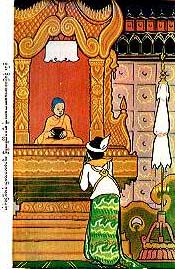
King Asoka regularly fed the Brahmin priests, in accordance with the custom of the royal household, before his conversion to Buddhism. But he was not pleased with their demeanour at meal-time, as they were neither clean nor calm. The King thought to himself, "Charity on such a lavish scale should be given in proper quarters". Later, one day he saw a serene-looking young novice, quietly walking along the street with restrained senses.
The King was so impressed with the deportment that the novice was invited to the palace at once and requested to occupy a suitable seat ; and the novice went up the throne and sat on it. The King then served him with an excellent meal and asked him to give an exposition of the Doctrine which his Teacher used to preach. The young novice Nigrodha delivered an instructive discourse on the following stanza of the Dhammapada:— "Heedfulness is the path to Deathlessness. Heedlessness is the path to death. The heedful do not die, the heedless are like unto the dead".
The word of the Buddha appealed to him and he became a Buddhist and staunch supporter of the religion.
THE THIRD BUDDHIST COUNCIL BEING HELD WITH THE VENERABLE MOGGALIPUTTA TISSA AS THE PRESIDING THERA
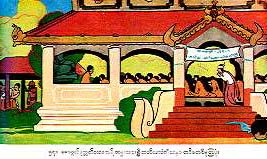
King Dhammasoka understood the essence of Buddhism, and gave great support to the cause of Buddhism by erecting rock-edicts in all parts of his territory enjoining upon the subjects to follow the Doctrine in their daily lives. With his royal patronage Buddhism flourished, and the Sasana gradually grew in importance and numbers. Tempted by worldly gain, many undesirables of alien sects joined the Order and polluted the Sasana by their corrupt lives and heretical views which they taught.
Good monks could not live together with these sham monks and there was trouble. The King consulted the Venerable Moggaliputta Tissa to protect the Sasana. The King tested the monks and disrobed the undesirables to purify the Sasana. The Third Buddhist Council was then held by 1000 Arahants. with the Venerable Moggaliputta Tissa as the presiding Thera.
KING VATTAGAMANI ABHAYA BEING ACCOMPANIED BY MONKS IN MARCHING OUT WITH HIS ARMY TO THE BATTLE-FRONT
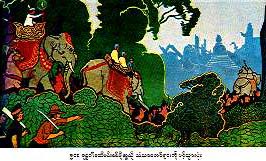
King Vattagamani Abhaya was a staunch supporter and defender of the Buddhist religion in the island of Lanka (Ceylon). One day when he was about to go out to fight the Tamil Kings, the King went to the monastery and said to the Mahatheras, "Venerable Sirs, I shall have to go across the Ganga (the river) to promote the cause of Buddhism, and wish the Theras to accompany me on my journeys so that I can pay my respects to them at all times."
The Mahatheras selected 500 monks who were in their prime of life and sent them to accompany the King. King Vattagamani carried on battle while at the same time attending to the personal needs of the Theras in his company with regard to their food, medicine, etc. The spear used by the King contained a sacred relic of the Buddha embedded in it at its end. His motto runs thus:—"I have been doing my best to make Buddhism last long and not for my own personal gain".
THE TIPITAKA BEING COMMITTED TO WRITING ON OLA (PALM) LEAVES DURING THE REIGN OF KING VATTAGAMANI ABHAYA
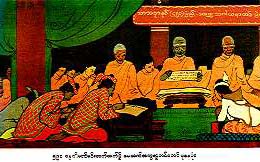
From the time of Buddha's life down to the time of King Vattagamani's reign, the Tipitaka forming the teachings of the Blessed One were handed down from generation to generation of monks by word of mouth, by being learnt by heart. During the reign of King Vattagamani, however, trouble was given by Brahmana Tissa, who rose up in arms and there was also inference from Kings who were disbelievers in the Buddhist religion. The monks could not get enough food for their meals and had to make extraordinary efforts to retain in memory whatever parts of the Buddhist scriptures they had already learnt by heart.
This was a matter for anxiety as, if the monks in future could not commit the Tipitaka scriptures to memory and recite them, the scriptures might disappear altogether. They therefore sought the assistance of King Vattagamani and held the Fourth Buddhist Council by committing the Tipitaka to writing on ola (palm) leaves.
The expression "Writing committed to palm leaves" has come into usage with reference to this first act of the letters of the alphabet being written down on ola (palm) leaves.
ANAWRATHA OF PAGAN CONVEYING THE BUDDHIST SCRIPTURES
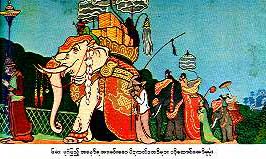
King Anawratha of Pagan conveyed the Buddhist scriptures from Thaton to Pagan for the benefit of all beings. He then removed the frontal bone, sacred relic of the Buddha, from Kaung-hmu-daw pagoda at Prome built by King Dutta-baung and took it also to Pagan. On arrival there he built a pagoda on the sand-bank of the Irrawaddy river near Pagan and enshrined the frontal bone of the Buddha, there. When the third terrace of this pagoda was constructed, he brought a replica of the Buddha's tooth from Sri Lanka and enshrined it also in this pagoda. Before the construction of this pagoda was completed King Anawratha died.
When Kyanzittha became King of Pagan in succession to Anawratha, he continued to build this pagoda as advised by the Venerable Arahan. This pagoda was known as Shwezigon (Golden Sandbank) pagoda because it stands upon a strip of sand bank. King Anawratha started its construction in 393 Burmese Era. (1033 C.E.) and Kyanzittha continued to build it and hoisted a golden hti(crown) on it in 452 Burmese Era. (1192 C.E.).

